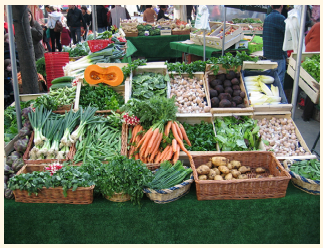12.2: Trailblazer
- Page ID
- 139486
Argumentative Research Trailblazer: Samin Nosrate

"I love doing the homework on recipes
and traditions . . . [I'm] excited to . . . read and research."
Figure \(12.2\) Fresh produce in markets like this one in France continue to inspire Samin Nosrat (https://openstax.org/r/saminnosrat)’s recipes and ideas about food. (credit: “Légumes” by Arnaud 25/ Wikimedia Commons, Public Domain)
Food writer, chef, and TV host Samin Nosrat (b. 1979) was born in San Diego, California, to Iranian parents who, as followers of the Baha’i faith, immigrated to the United States to avoid religious persecution in their native country. When she was a student at the University of California, Berkeley, Nosrat became interested in cooking after a dinner at Berkeley’s well-known Chez Panisse, the restaurant belonging to award-winning chef, author, and food activist Alice Waters (b. 1944). Indeed, Nosrat became so interested that she got a job bussing tables at the restaurant several months later. After a year, she “moved up” to the kitchen, where she became a cook, working with Chez Panisse chef Cal Peternell.
Nosrat is well known for her cookbook Salt, Fat, Acid, Heat: Mastering the Elements of Good Cooking (2017), which won the prestigious James Beard Award in 2018 and also reached the New York Times best seller list that year. In the book, Nosrat claims that “like a scholar in search of primary sources,” she wanted “to experience authentic versions of the dishes” she loved. In addition to being a chef and writer, she has hosted an award-winning Netflix docuseries based on her book and until February 2021 was a regular columnist for The New York Times Magazine.
The underlying thesis of Nosrat’s Salt, Fat, Acid, Heat (https://openstax.org/r/saltfatacid) is that one should trust their senses in the kitchen, building confidence and developing the knowledge to gain this trust. Nosrat emphasizes an intuitive, elemental approach to cooking. “Anyone can cook anything and make it delicious,” Nosrat claims in the book’s introduction, establishing that excellent cooking is based on skill in using and balancing the four basic elements named in the title. She found solid evidence for this stance in Japan, where the cuisine features salt; in Italy, where the cuisine features fat; in Mexico, where the cuisine features acid; and in California, where the cuisine features heat. Nosrat explains these four elements in detail and supports her premise with research, interviews, and internships with talented cooks in different countries.
When talking about her television show, Nosrat says, “Good food around the world is more similar than it is different.” She considers how the chemistry and the culture of cooking work together around the world to create universally good food and, at the same time, create empathy and common ground. Nosrat’s audience can thus discern a persuasive purpose to her research into cooking. She argues that in addition to food, cooking is about people, and she hopes that by eating the food of a particular culture, readers and viewers will develop compassion for the people of that culture, despite politics or history. Seeking answers to important questions, Nosrat asks, “Does [food] really matter? Can food make a difference?”
As she continues her mission of research and writing, Nosrat feels the responsibility of her calling: to provide greater cross-cultural understanding and to center minoritized voices and traditions. She wants readers to feel safe inside her book, supported by the context she provides and her sensitivity to culture.
Discussion Questions
- Consider the rhetorical situation: In what ways does Samin Nosrat’s writing respond to purpose, audience, genre, stance, culture, and context?
- In what ways does Nosrat aim to make the cookbook genre persuasive or argumentative?
- What is Nosrat’s claim in Salt, Fat, Acid, Heat?
- In what ways does Nosrat present reasoning and evidence?
- In what ways does Nosrat use research to support her claim?


